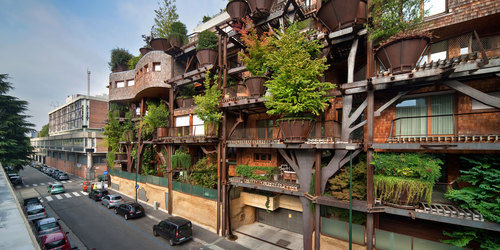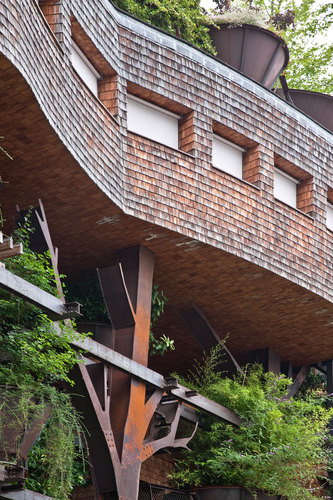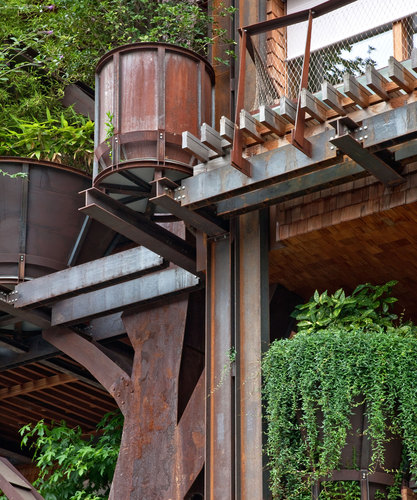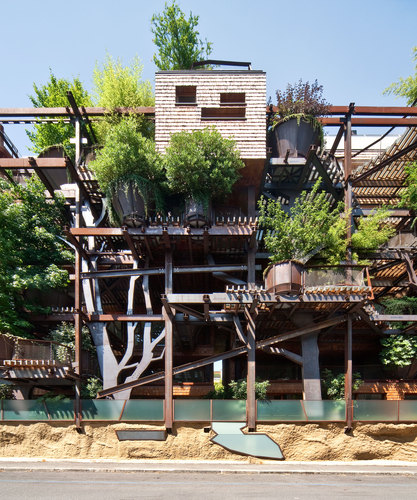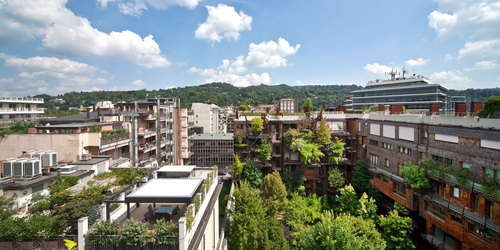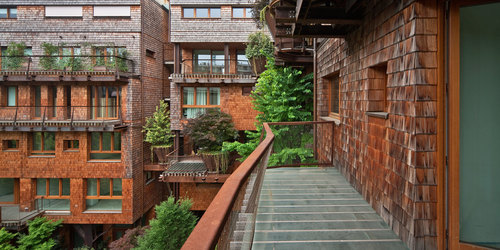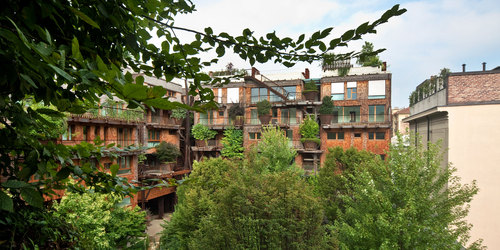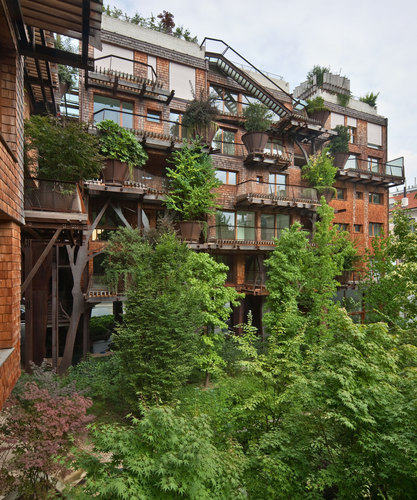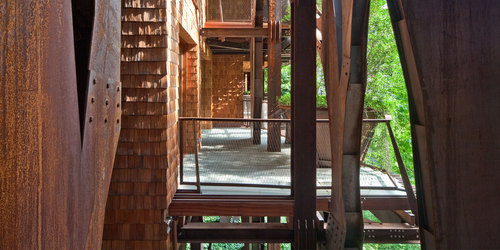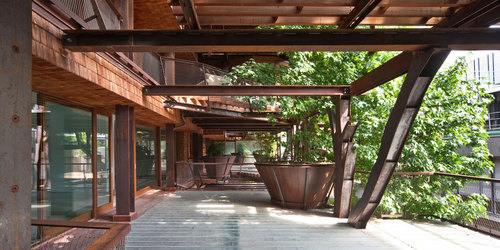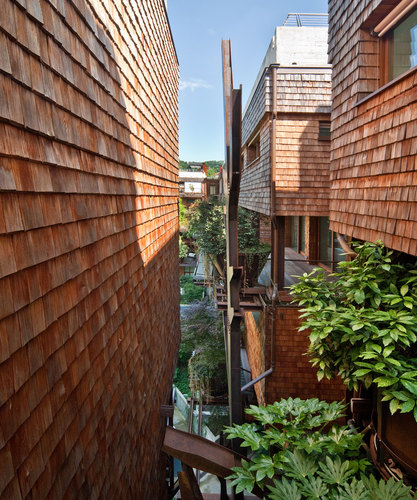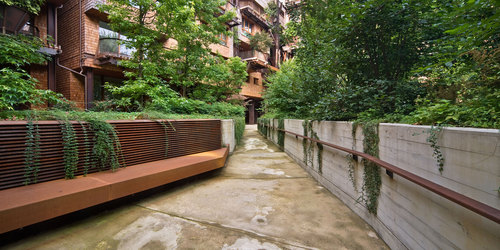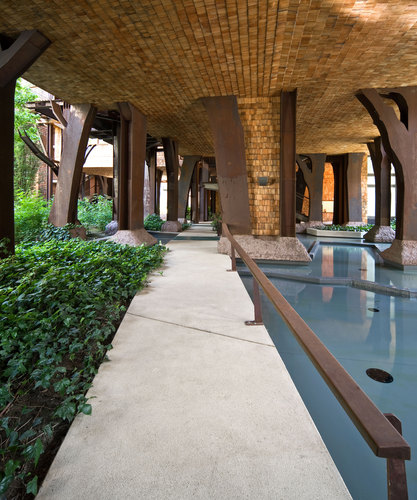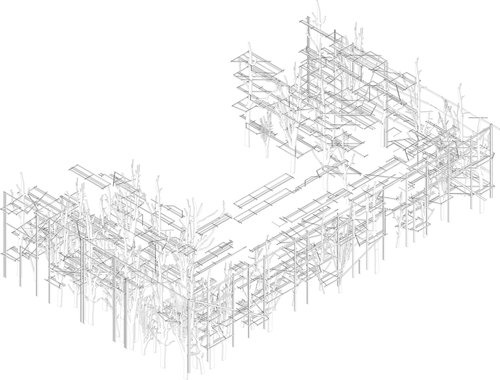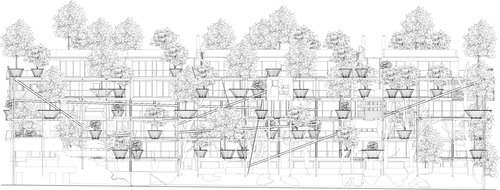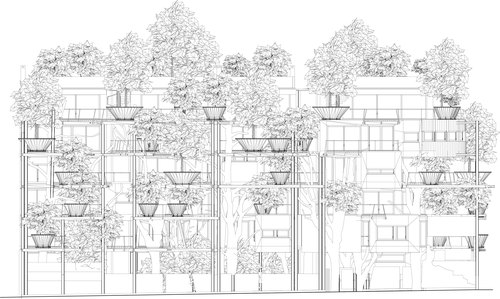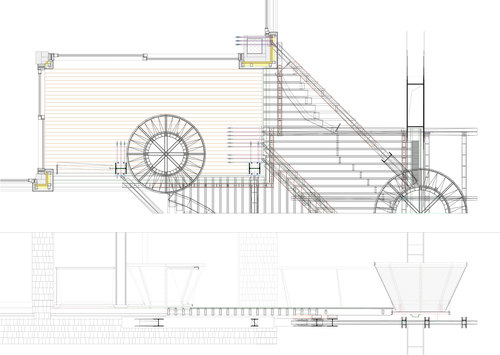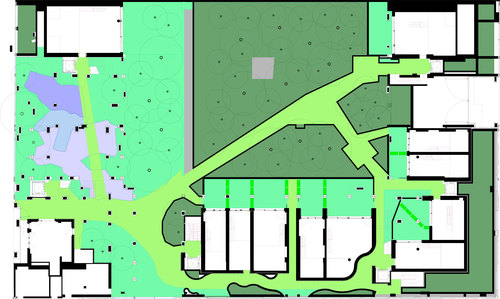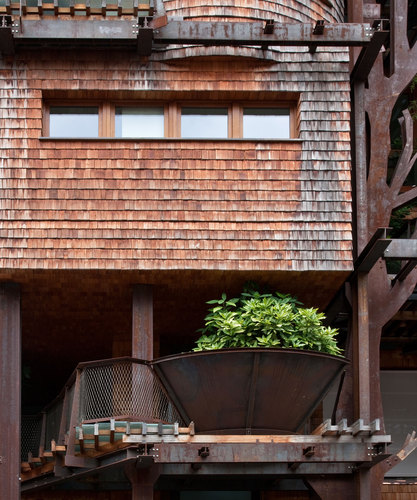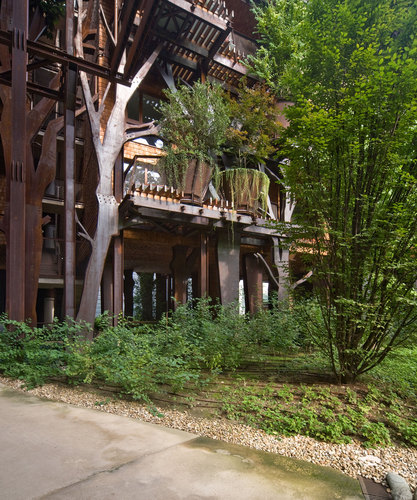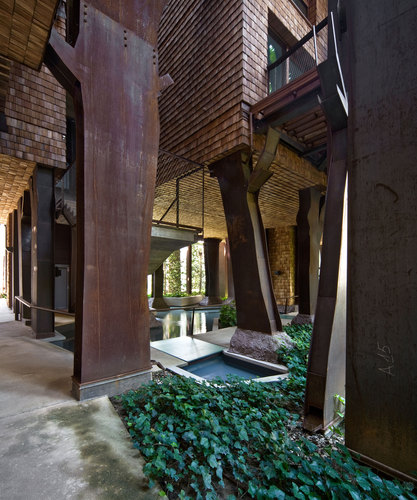Le case tra gli alberi
A Torino ha messo radici una nuova casa. Ha strutture in acciaio come alberi di una foresta. Piante che immergono le loro radici in terrazzi dai profili irregolari. Specchi d’acqua attraversati da passerelle. E sui tetti, rigogliosi giardini. L’intera costruzione è concepita come una sorta di foresta abitabile, una casa sugli alberi come quella che tutti i bambini sognano e, a volte, costruiscono. Il progetto nasce dall’esigenza di realizzare un edificio residenziale di completamento dell’isolato urbano, già caratterizzato da disomogeneità ed affacci eterogenei.
![Luciano Pia — 25 Verde Luciano Pia — 25 Verde]()
© Beppe Giardino . Published on March 02, 2015.
L’intervento si pone l’obbiettivo di edificare il perimetro su fronte via, con un filo edilizio compatto, ma nello stesso tempo di realizzare un filtro di transizione tra lo spazio esterno delle vie e lo spazio interno edificato. Il fine ricercato dal progetto è di creare uno spazio di transizione fluido e morbido che smorzi il brusco passaggio dal dentro al fuori e sia fruibile sia dall’interno che dall’esterno. Questo passaggio morbido e mutevole nel tempo, è accentuato da un uso mirato del verde e dei materiali utilizzati che ne favoriscono la transizione, creando nel contempo un “blocco edificato” definito e compatto, ma permeabile, mutevole e vivibile. E’ un edificio speciale, perché vivo: cresce, respira e cambia nel tempo perché i suoi terrazzi sono costellati da 150 alberi ad alto fusto che, insieme alle 50 piante nella corte, producono ogni ora circa 150.000 litri di ossigeno, mentre nella notte assorbono circa 200.000 litri di anidride carbonica all’ora. Inoltre abbattono le polveri sottili provocate dalle autovetture, proteggono dal rumore, seguono il naturale ciclo delle stagioni, crescono giorno dopo giorno, creano un microclima ideale all’interno dell’edificio mitigando gli sbalzi di temperatura in estate ed inverno. I listelli di legno massello che pavimentano i terrazzi irregolari filtrano i raggi del sole in estate, mentre in inverno lasciano penetrare la luce all’interno delle abitazioni. Il rivestimento in scandole di larice delle facciate, crea una superfice morbida e vibrante.
![Luciano Pia — 25 Verde Luciano Pia — 25 Verde]()
© Beppe Giardino . Published on March 02, 2015.
Le strutture metalliche alberiformi che contornano l’edificio nascono dal piano terra e crescono fino al tetto, sorreggendo gli impalcati lignei dei terrazzi; intrecciandosi con la vegetazione costituiscono la facciata dell’edificio, unica nel suo genere. Uno degli obiettivi dell’intervento è il raggiungimento di una buona efficienza energetica. Per questo sono state adottate numerose soluzioni integrate: isolamento “a cappotto” , pareti ventilate, protezione dall’irraggiamento solare diretto, impianti di riscaldamento e raffrescamento che utilizzano l’acqua di falda con il sistema a pompa di calore, recupero delle acque piovane, stoccaggio e riutilizzo per l’irrigazione del verde. Il fabbricato ospita 63 unità immobiliari, tutte diverse tra loro e dotate sui due lati di generosi terrazzi di forma irregolare che avvolgono la vegetazione.
![Luciano Pia — 25 Verde Luciano Pia — 25 Verde]()
© Beppe Giardino . Published on March 02, 2015.
L’ultimo piano, coperto da tetti verdi privati, è organizzato con unità di taglio maggiore. Il sistema del verde è differenziato: fioriere sui terrazzi, giardino-corte, verde verticale in facciata, verde pensile nella zona del soppalco dove si affacciano i loft, verde pensile in copertura. Le fioriere ospitano, a seconda delle dimensioni, alberi o arbusti. Anche le altezze a disposizione sono diverse e vanno da 2,5 metri di altezza a oltre gli 8 metri. Sono state scelte principalmente specie decidue, per permettere l’irraggiamento solare nel periodo invernale. La scelta delle essenze, sebbene differenziata in base alle diverse esigenze, è stata fatta per assicurare una varietà di portamento, fogliame, fioritura e colore. Quando tutto il verde sarà nel pieno rigoglio, sarà come vivere in una casa sull’albero. Si può sognare una casa, oppure si può abitare un sogno.
![Luciano Pia — 25 Verde Luciano Pia — 25 Verde]()
© Beppe Giardino . Published on March 02, 2015.
Crediti
LUOGO: VIA CHIABRERA 25, TORINO
PROGETTO e Direzione dei Lavori: Arch. Luciano Pia – Torino
CRONOLOGIA:.inizio lavori 2010, fine lavori 2011
DATI DIMENSIONALI. Sup. terreno 3570 mq; sup. residenziale 7500 mq
Progetto e Direzione Lavori Opere Strutturali: Ing. Giovanni Vercelli -Torino
PROGETTISTI DEL PAESAGGIO: LINEEVERDI (Dott. Agr. Stefania Naretto, Dott. Agr. Chiara Otella)- Torino
COMMITTENTE : GRUPPO CORAZZA, MAINA COSTRUZIONI, DE-GA S.P.A.
IMPRESA ESECUTRICE: DE-GA S.p.A. – Torino
![Luciano Pia — 25 Verde Luciano Pia — 25 Verde]()
© Beppe Giardino . Published on March 02, 2015.
![Luciano Pia — 25 Verde Luciano Pia — 25 Verde]()
© Beppe Giardino . Published on March 02, 2015.
![Luciano Pia — 25 Verde Luciano Pia — 25 Verde]()
© Beppe Giardino . Published on March 02, 2015.
![Luciano Pia — 25 Verde Luciano Pia — 25 Verde]()
© Beppe Giardino . Published on March 02, 2015.
![Luciano Pia — 25 Verde Luciano Pia — 25 Verde]()
© Beppe Giardino . Published on March 02, 2015.
![Luciano Pia — 25 Verde Luciano Pia — 25 Verde]()
© Beppe Giardino . Published on March 02, 2015.
![Luciano Pia — 25 Verde Luciano Pia — 25 Verde]()
© Beppe Giardino . Published on March 02, 2015.
![Luciano Pia — 25 Verde Luciano Pia — 25 Verde]()
© Beppe Giardino . Published on March 02, 2015.
![Luciano Pia — 25 Verde Luciano Pia — 25 Verde]()
© Beppe Giardino . Published on March 02, 2015.
![Luciano Pia — 25 Verde Luciano Pia — 25 Verde]()
© Beppe Giardino . Published on March 02, 2015.
![Luciano Pia — 25 Verde Luciano Pia — 25 Verde]()
© Beppe Giardino . Published on March 02, 2015.
![Luciano Pia — 25 Verde Luciano Pia — 25 Verde]()
© Luciano Pia . Published on March 02, 2015.
![Luciano Pia — 25 Verde Luciano Pia — 25 Verde]()
© Luciano Pia . Published on March 02, 2015.
![Luciano Pia — 25 Verde Luciano Pia — 25 Verde]()
© Luciano Pia . Published on March 02, 2015.
![Luciano Pia — 25 Verde Luciano Pia — 25 Verde]()
© Luciano Pia . Published on March 02, 2015.
![Luciano Pia — 25 Verde Luciano Pia — 25 Verde]()
© Luciano Pia . Published on March 02, 2015.
![Luciano Pia — 25 Verde Luciano Pia — 25 Verde]()
© Beppe Giardino . Published on March 03, 2015.
![Luciano Pia — 25 Verde Luciano Pia — 25 Verde]()
© Beppe Giardino . Published on March 03, 2015.
![Luciano Pia — 25 Verde Luciano Pia — 25 Verde]()
© Beppe Giardino . Published on March 03, 2015.









































































































